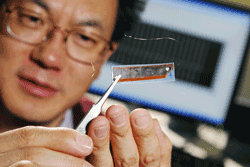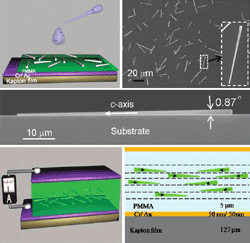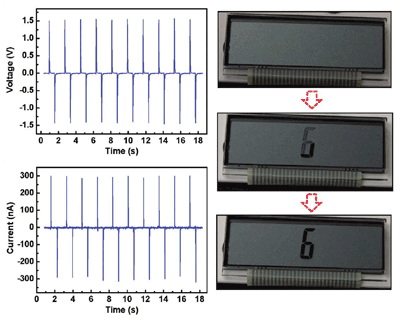Capping a five-year effort, a team of five researchers — Youfan Hu, Yan Zhang, Chen Xu, Guang Zhu, and Zhong Lin Wang — from the School of Material Science and Engineering at the Georgia Institute of Technology in Atlanta have created a flexible, energy-harvesting nanoscale generator capable of powering a conventional electronic devices, in this instance, a liquid crystal numeric display. The reseachers have also developed a fabrication technique that is relatively simple, and could scale for volume manufacturing.

Professor Zhong Lin Wang holds the nonowires-based generator created by his team at Georgia Tech.
The so-called nanogenerator uses conical zinc oxide (ZnO) nanowires to create a piezoelectric layer in which an electric potential is created when the material is flexed or compressed. Devices created from these nanowires by Wang and his research team can produce as much as 3 V and 300 nA.
The basic structure of the nanogenerator is a composite sandwiched between metal films. The composite is a unipolar assembly of nanowires suspended in polymethyl methacrylate (PMMA), a transparent, shatter-resistant thermoplastic often used in place of glass.
To construct the generator, ZnO nanowires with lengths over 30 μm were grown on a solid substrate using a vapor deposition process. The wires have a conical shape due to the fastest growth being along the c axis and a much slower growth rate in the basal plane. The conical nanowires on the substrate were soaked into ethanol, and applying an ultrasonic wave effectively chopped off the nanowires from the substrate, forming a freely suspended nanowire/alcohol solution.
Separately, a Cr/Au (50 nm/50 nm) metal layer was deposited on flexible 127-μm Kapton film by electron beam evaporation. Then a layer of PMMA about 2 μm thick was spun coated on the metal film. By dispersing a droplet of the nanowire/alcohol solution onto the PMMA film, the nanowires were fairly uniformly distributed on the substrate surface with random lateral orientations (see Fig. 1 ). The area density of the nanowires on the substrate was low (1,400 to 1,500 nanowires per mm2 ) to avoid overlapping and aggregations among the wires.

Fig. 1. To fabricate the nanogenerator, droplets containing nanowires are dispersed on PMMA film (top left) resulting in the conical nanowires being fairly uniformly distributed on the substrate surface with random lateral orientations. In the cross-section SEM image (center) the bottom surface of the nanowire is tightly attached to the substrate, and the conical angle is 0.87°. The white arrowhead indicates that the c axis of the nanowire is pointing downward into the substrate. The completed structure of the device structure and the working principle of the structure is shown at bottom.
After alternately spin coating PMMA and dropping-on the nanowire solution five times, another thicker PMMA layer (about 2 μm) was deposited, and Cr/Au metal film was deposited on top of the PMMA to serve as an electrode. The size of the whole device was about 1.5 × 2 cm2, and the generator was attached to a flexible polystyrene substrate about 1 mm thick; it can be robustly bent for many cycles. When flexed, the device generated enough power to drive a commercial display borrowed from a pocket calculator (see Fig. 2 ).

Fig. 2. Mechanically straining the nanogenerator at a frequency of 0.56 Hz allows it to drive an LCD. The measured output of the nanogenerator has a peak voltage of 1.5 V and peak current of 300 nA. Three snapshots taken of the LCD show that part of the character “6” was lit up at first, and then all of the segments were lit continuously afterward.
Professor Wang believes this process can be scaled up to industrial production. Earlier zinc oxide nanogenerators required careful growth of the nanowire arrays and painstaking assembly. “By simplifying our design, making it more robust and integrating … many more nanowires, we have successfully boosted the output of our nanogenerator enough to drive devices such as commercial liquid-crystal displays, light-emitting diodes and laser diodes,” said Wang. “If we can sustain this rate of improvement, we will reach some true applications in health-care devices, personal electronics, or environmental monitoring.”
Wang says the nanogenerators are now close to producing enough current for a self-powered system that might monitor the environment for toxic gas, for instance, then broadcast a warning. The system would include capacitors able to store up the small charges until enough power was available to send out a burst of data.
While even the current nanogenerator output remains below the level required for such devices as iPods or cardiac pacemakers, Wang believes those levels will be reached within three to five years. The current nanogenerator, he notes, is nearly 100 times more powerful than what his group had developed just a year ago.
The work has been supported by the Defense Advanced Research Projects Agency (DARPA), the U.S. Department of Energy, the U.S. Air Force, and the National Science Foundation. For more information, contact Professor Wang at 404-894-8008, zhong.wang@mse.gatech.edu.
Richard Comerford
Advertisement
Learn more about Georgia Institute of Technolog





